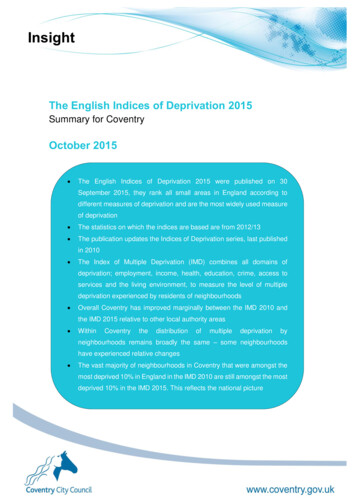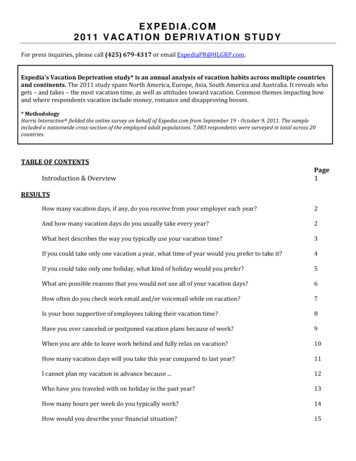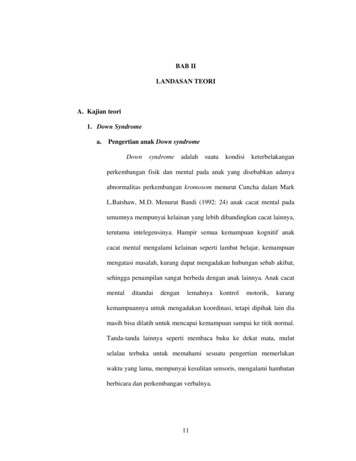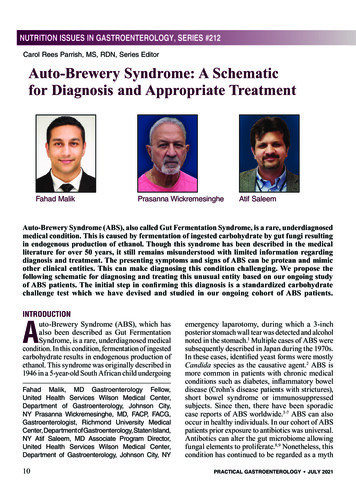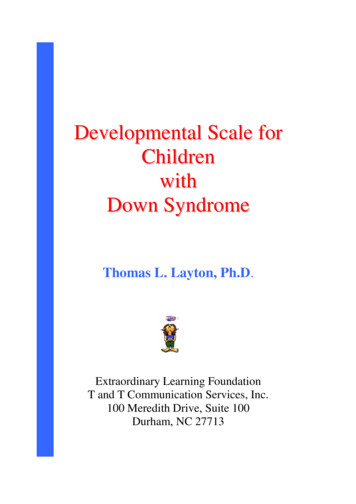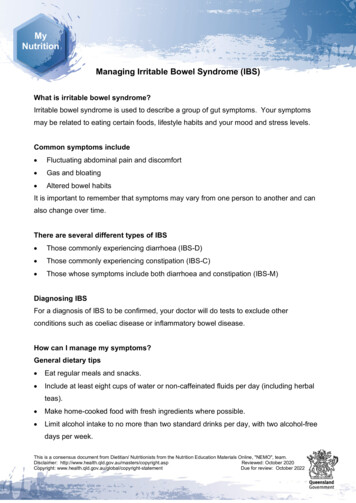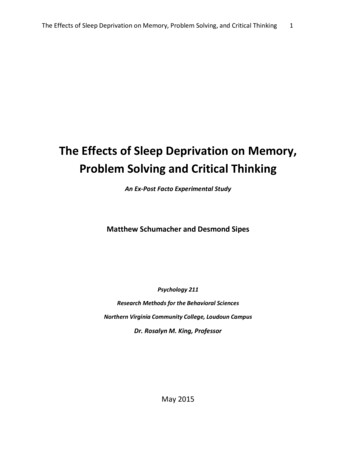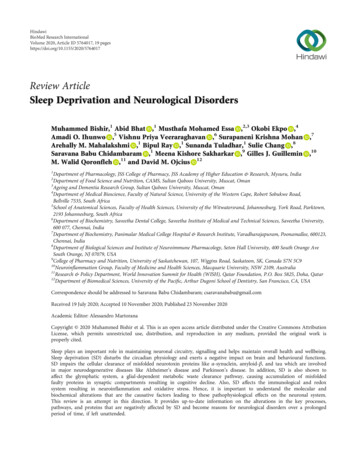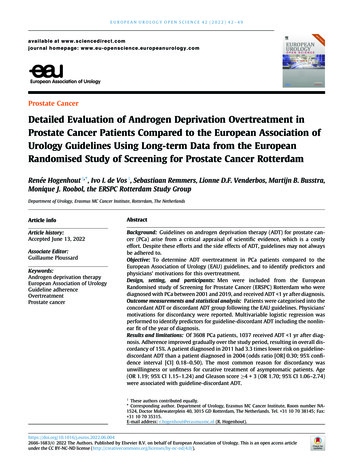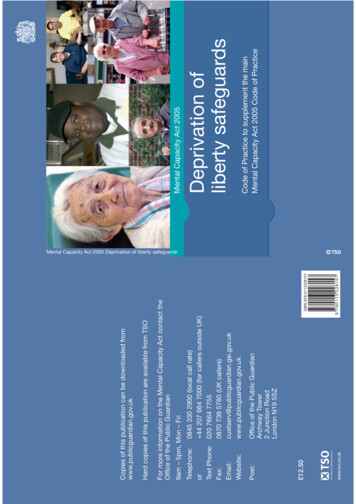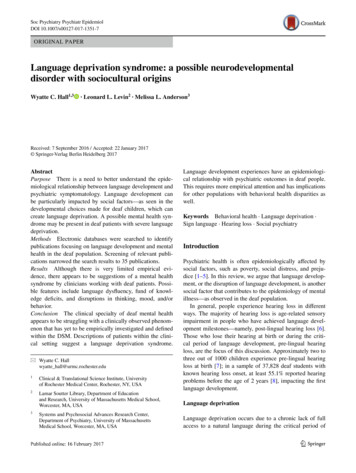
Transcription
Soc Psychiatry Psychiatr EpidemiolDOI 10.1007/s00127-017-1351-7ORIGINAL PAPERLanguage deprivation syndrome: a possible neurodevelopmentaldisorder with sociocultural originsWyatte C. Hall1,3· Leonard L. Levin2 · Melissa L. Anderson3Received: 7 September 2016 / Accepted: 22 January 2017 Springer-Verlag Berlin Heidelberg 2017AbstractPurpose There is a need to better understand the epidemiological relationship between language development andpsychiatric symptomatology. Language development canbe particularly impacted by social factors—as seen in thedevelopmental choices made for deaf children, which cancreate language deprivation. A possible mental health syndrome may be present in deaf patients with severe languagedeprivation.Methods Electronic databases were searched to identifypublications focusing on language development and mentalhealth in the deaf population. Screening of relevant publications narrowed the search results to 35 publications.Results Although there is very limited empirical evidence, there appears to be suggestions of a mental healthsyndrome by clinicians working with deaf patients. Possible features include language dysfluency, fund of knowledge deficits, and disruptions in thinking, mood, and/orbehavior.Conclusion The clinical specialty of deaf mental healthappears to be struggling with a clinically observed phenomenon that has yet to be empirically investigated and definedwithin the DSM. Descriptions of patients within the clinical setting suggest a language deprivation syndrome.* Wyatte C. Hallwyatte hall@urmc.rochester.edu1Clinical & Translational Science Institute, Universityof Rochester Medical Center, Rochester, NY, USA2Lamar Soutter Library, Department of Educationand Research, University of Massachusetts Medical School,Worcester, MA, USA3Systems and Psychosocial Advances Research Center,Department of Psychiatry, University of MassachusettsMedical School, Worcester, MA, USALanguage development experiences have an epidemiological relationship with psychiatric outcomes in deaf people.This requires more empirical attention and has implicationsfor other populations with behavioral health disparities aswell.Keywords Behavioral health · Language deprivation ·Sign language · Hearing loss · Social psychiatryIntroductionPsychiatric health is often epidemiologically affected bysocial factors, such as poverty, social distress, and prejudice [1–5]. In this review, we argue that language development, or the disruption of language development, is anothersocial factor that contributes to the epidemiology of mentalillness—as observed in the deaf population.In general, people experience hearing loss in differentways. The majority of hearing loss is age-related sensoryimpairment in people who have achieved language development milestones—namely, post-lingual hearing loss [6].Those who lose their hearing at birth or during the critical period of language development, pre-lingual hearingloss, are the focus of this discussion. Approximately two tothree out of 1000 children experience pre-lingual hearingloss at birth [7]; in a sample of 37,828 deaf students withknown hearing loss onset, at least 55.1% reported hearingproblems before the age of 2 years [8], impacting the firstlanguage development.Language deprivationLanguage deprivation occurs due to a chronic lack of fullaccess to a natural language during the critical period of13Vol.:(0123456789)
Soc Psychiatry Psychiatr Epidemiollanguage acquisition (when there is an elevated neurological sensitivity for language development), approximatelythe first 5 years of a child’s life [9, 10]. Language deprivation during the critical period appears to have permanentconsequences for long-term neurological development [11].Neurological development can be altered to the extent thata deaf child “may be unable to develop language skills sufficient to support fluent communication or serve as a basisfor further learning” [12].Exposure to a fully accessible language has an independent influence on brain development separate from theauditory experience of hearing loss. Indeed, recent neuroimaging studies indicate the presence of adult neurostructural differences in deaf people based on timing and qualityof language access in the early childhood [13–15].Access to spoken languageMedical professionals are not able to assure that hearing aids and cochlear implants will result in positive language outcomes [16]. Many deaf children are significantlydelayed in language skills despite their use of cochlearimplants. Large-scale longitudinal studies indicate significant variability in cochlear implant-related outcomes whensign language is not used, and there is minimal predictive knowledge of who might and who might not succeedin developing a language foundation using just cochlearimplants [17].For example, a study of 27 French-speaking implantedchildren found that only half of these children displayedlanguage skills comparable to their hearing peers at theword level and less than half at the sentence level [18].Long-term language trajectories of 188 implanted childrenwere described as “slower and more variable” than their97 hearing peers and even those who were implanted earlier than 18 months of age continued to exhibit languagedelays of more than a year behind their peers [19]. Studies of long-term speech production and perception in 110implanted children found extreme variability as some demonstrated zero ability to express or perceive spoken English clearly, while others performed nearly as high as 100%accuracy from elementary school to high school [20, 21].Finally, a meta-analysis of 12 studies focusing on spokenlanguage vocabulary found that implanted children had significantly less expressive and receptive vocabulary knowledge than their hearing peers [22].Access to visual languageIn contrast to depending solely on spoken language, anothercommunication option for deaf children is sign language—a fully accessible, visual language for deaf children. Contrary to popular—but uninformed—opinion, sign languages13have their own grammars and linguistic rules equivalent tospoken languages [23]. Yet, less than 8% of deaf childrenreceive regular access to sign language in the home (i.e.,fluent, bidirectional conversations) [8]. Although usingsign language is encouraged for hearing babies to developlanguage skills before they can begin to speak, sign language is not routinely offered as a primary or complementary intervention for deaf children; rather, if offered at all,it is often proposed as a last-resort option to deaf childrenwho have not developed speech abilities as expected [24].This pattern occurs—because many advocates, professionals, and educators believe that sign language acquisition will interfere with deaf children’s development ofspeech skills [25, 26]—despite research that has shownsigning implanted children actually demonstrate betterspeech development, language development, and intelligence scores than non-signing implanted children [20, 27,28]. This resistance has recently been described as a prejudice against both sign languages and the state of being deaf[29]. As a result, delayed exposure to sign language is a“common educational occurrence arising from the priorityfrequently given to speech over sign by rehabilitation professionals and hearing parents” [9]. The end result is thatmost deaf children do not develop native fluency in signlanguage.Based on the current literature, results suggest thattechnological interventions (e.g., hearing aids, cochlearimplants) are insufficient as a stand-alone approach for language acquisition in deaf children. Paired with delayed orabsent exposure to sign language during the critical periodof language acquisition, a deaf child can be at risk for experiencing long-term language deprivation—which leads toa spectrum of neurological, educational, and developmental consequences across the lifepan. Therefore, many deafchildren are likely experiencing some level of languagedeprivation that might contribute to greater health disparities relative to the general population, such as the increasedprevalence of mental illness seen in the deaf population.Behavioral healthDeaf individuals experience a higher prevalence ofbehavioral health concerns than the general population.For example, a study conducted with a community sampleof 236 deaf individuals found significantly poorer qualityof life and higher levels of emotional distress comparedto the general population [30]. Deaf female undergraduates are two times as likely to experience interpersonaltrauma [31]. In addition, a community sample of 308deaf individuals found elevated reports of lifetime emotional abuse (27.5%), physical abuse (21.0%), and sexualviolence (20.8%) [32]. Deaf adolescents can experience emotional and behavioral mental health problems
Soc Psychiatry Psychiatr Epidemiolassociated with low self-esteem and peer rejection [33],and a range of developmental adversities unique to beingdeaf in a hearing world, such as lack of accessible communication with parents and peers [34].While overall increased rates of mental health problems and extreme barriers to behavioral health care arereported in the deaf population, the early access to family and peer communication are protective factors againstthese disparities [35]. Indeed, some claim that the higherprevalence of trauma and psychiatric symptoms in thedeaf population are partially caused by inappropriate and/or incomplete medical and educational language interventions early in life [24, 36–39], which create risk forsubsequent language deprivation and behavioral healthproblems. These associations warrant further researchto guide interventions to target these mental health challenges in the deaf population.The hypothetical existence of a unique mental healthsyndrome that has a relationship with language deprivation deserves investigation as language difficulties complicate diagnosis and treatment of many deaf patients [38,40–43]. There is a need to help clinicians to differentiate primary and secondary contributors to deaf patients’mental health issues. The current structured literaturereview attempts to clarify potential psychiatric symptomsresulting from language deprivation and to investigatewhether such suggestions of a mental health syndromeexist.Fig. 1 Search strings bydatabaseMethodSearch strategyFive indexed databases were used for the literature searchto identify articles that discuss the impact of language onmental health in the deaf population: MEDLINE (PubMedinterface), PsycINFO (OVID interface), EMBASE (Scopussearch engine), CINAHL, and ERIC (EBSCO interface).Searches were iteratively constructed to identify the mosteffective search terms and syntax. As a major goal was todocument the literature over time, the authors looked backas far as possible within each database. No restrictions wereplaced on types of material to ensure that relevant literature would be included from English-only journals, books,and theses/dissertations. Figure 1 shows the search strategyapplied to each database.The initial searches for the identification stage were conducted in January 2015. Results were imported into theRefWorks citation management database. Using RefWorks’de-duplication feature, duplicate publications were eliminated. These publications were then exported into Excel.Inclusion criteriaPublications needed to meet the following criteria for inclusion in the structured literature review: (a) focus on the deafpopulation; (b) focus on at least one aspect of languagePubMed Search String:("Persons With Hearing Impairments"[Mesh] OR "Deafness"[Mesh:noexp]) AND("Language Development"[Mesh] OR "Language Development Disorders"[Mesh] OR"Language"[Mesh] OR "Cognition"[Mesh] OR "Communication Barriers"[Mesh] OR"Speech"[Mesh]) AND "Mental Disorders"[Mesh]PsycINFO Search String:exp Hearing Disorders AND (exp Speech Development OR exp Language Development)Scopus (including EMBASE) Search String: (Hearing Impairment) AND (LanguageAcquisition OR Interpersonal Communication) AND (Mental Disease OR Mental HealthOR Posttraumatic Stress Disorder OR Dissociation)ERIC Search String:(descriptor:deafness OR descriptor:hearing impairment) AND (descriptor:languageimpairments OR descriptor:language acquisition OR decriptor:language aptitude) AND(descriptor:mental disorders OR descriptor:mental health)CINAHL Search String:(MH “Deafness” OR MH “Hearing Impairment”) AND (MH “Language Impairments”OR MH “Language Acquisition” OR MH “Language Aptitude”) AND (MH “MentalDisorders” OR MH “Mental Health”)13
Soc Psychiatry Psychiatr Epidemioldevelopment; and, (c) focus on behavioral health (i.e., mental health or substance use disorder). Due to the complexnature of language development and mental health outcomes, certain publications were accepted without meetingall the criteria if they provided important context.Abstraction formAn abstraction form is a standard method of systematicallycollecting data from literature reviews based on inclusioncriteria. Our form elicited the following information abouteach included study: (1) description of the deaf individualsin the study sample; (2) type of language exposure; (3) typeof intervention (where applicable; e.g., cochlear implant,social skills training, cognitive behavioral therapy), and (4)reported mental health/behavioral outcomes.Search resultsFigure 2 utilizes the Preferred Reporting Items for Systematic Reviews and Meta-Analyses (PRISMA) flow diagram [44], demonstrating the structured literature reviewsteps up to the full-text review. During the identificationstage, 1505 publications were identified through database searching and 40 additional publications were foundthrough other sources (e.g., Google Scholar, bibliography hand-searching). The screening process eliminated1372 publications, the remaining 173 were given full-textreviews. Fourteen non-English publications were immediately excluded. Upon full-text review, further 49 publications were excluded. Abstraction forms were used for theremaining 110 full-text publications.Seventy-five full-text publications were excluded during abstraction form review. The remaining 35 full-textIdentificationFig. 2 PRISMA flow diagramRecords identified throughdatabase searching(n 1,505 )Additional records identifiedthrough other sources(n 40)EligibilityScreeningRecords after duplicates removed(n 1,538)Records screened(n 1,538)Records excluded(n 1,372)Full-text articlesassessed for eligibility(n 173)Full-text articlesexcluded, non-English(n 14)IncludedStudies included inqualitative synthesis(n 35)13Studies included inquantitative synthesis(meta-analysis)(N/A)
Soc Psychiatry Psychiatr Epidemiolpublications were included in this paper, forming the basisof the structured literature review. The Appendix detailsthe abstraction form results of the 35 structured literaturereview publications.ResultsHistorical attempts of developing diagnostic conceptsand termsDiscussions of a potentially unique clinical disorder inthe deaf mental health field appear to have begun in the1960s [45–48]. Psychiatric diagnosis of deaf patients wasdescribed as extremely complex and time-consuming [49].Unfortunately, there has been a general lack of awareness inthe psychiatry field towards these unique deaf clinical presentations and features. This led one clinician to describeconsistent misdiagnoses and clinical confusion associated with deaf patients as “catastrophic mistakes [leadingto] unnecessary and prolonged hospitalizations, placingpatients on [unnecessary] powerful psychotropic medications, and the failure to develop appropriate treatment programs or provide needed services” [38].Various categorical terms were proposed, includingsurdophrenia and primitive personality. The term surdophrenia stems from Basilier’s “Psychic Consequences ofCongenital or Early Acquired Deafness” [46] and primitivepersonality was coined by Altshuler in several early 1960spublications [45] which compared some deaf patients toferal children abandoned in the wild (i.e., The Wild Boyof Aveyron [50]). The general theory behind these termswas that a unique cluster of mental health symptoms (e.g.,behavioral issues, cognitive delays, and lack of socialskills) resulted from unavoidable communication difficulties of deafness (i.e., inadequate exposure to spoken orsigned language).Vernon and Raifman [51] explain their diagnosis of“primitive personality: surdophrenia” as applying to asubpopulation of approximately 5–15% of deaf individuals who have a linguistic disability that creates severe cognitive deprivation, as well as psychological naiveté andimmaturity. Their suggested criteria include: (1) minimalor total absence of language knowledge (including sign language, English, or other language); (2) functional illiteracyas measured by a standardized educational achievementtest; (3) a history of little or no formal education; (4) cognitive deprivation involving little or no knowledge of basics,including paying taxes, or following recipes, etc., and, (5) aperformance IQ score of 70 or less.Clinical descriptions of patients often referred to “problem behaviors of deafness,” invariably including some reference to immaturity, impulsiveness, explosiveness, andgeneral lack of skills (e.g., “soft skills”) that promote success in society [49, 52]. Since that time, criticism of thissentiment in the literature—in which there appeared tobe an underlying belief that these behaviors were actuallycharacteristic of deaf people themselves—has redirectedthese “problem behaviors of deafness” as a consequenceof language deprivation or other adverse developmentalexperiences [37]. Glickman [41] attempted to address theweaknesses and bias of the previous diagnostic attempts bydeveloping his own label and criteria (Fig. 3), with the goalof further solidifying a potential diagnostic concept.Language dysfluencyLanguage dysfluency occurs when a person’s best languageis considered not fluent [38]. Ironically, although languagedysfluency may be more common in deaf people, literature discussing language dysfluency in deaf individualsis extremely limited. Dysfluency may be caused by eitherlanguage deprivation and/or neurological deficits unrelatedto language deprivation, including life events (such as traumatic brain injuries and prenatal illness) and mental illness[53].It can be more difficult to assess deaf individual’s psychiatric symptoms due to extremely wide variability indevelopmental language experiences that lead to variabledegrees of language dysfluency in many deaf patients [54].An inpatient unit serving deaf patients documented a highprevalence of language dysfluency using subjective communication assessments [38, 55]. Approximately, 75% ofpatients were found to be language dysfluent, yet only 28%to have a psychotic disorder (compared to 88.9% of hearing inpatients) [55], but the generalizability of these findings is unknown. As a result, many deaf patients appear tobe hospitalized not for mental illness, but for the varioussequelae related to language deprivation—including language dysfluency—that social and medical systems failedto adequately address.Languages in either modality (auditory or visual) haverules and structures that make them languages; some suggest that language dysfluency may cause disruption in theserules and structures. Descriptions of psychosis-related signlanguage dysfluency suggest that it follows “classic” symptoms seen in hearing patients including neologisms, clangassociations, and content poverty, among others [54, 56].One clinician’s case study of a deaf inpatient withsuggested non-psychotic language dysfluency highlightslimited vocabulary, lack of time referents, disturbed spatial organization, and lack of syntax as possible key features of language deprivation-related dysfluency in signlanguage [for a review, see 38]. A language-dysfluentpatient’s vocabulary may be limited to “concrete objects,actions, and descriptions [a person] has experienced13
Soc Psychiatry Psychiatr EpidemiolFig. 3 Glickman’s proposedcriteria of “language deprivation with deficiencies in behavioral, emotional, and socialadjustment”a. The person is born with a hearing loss severe enough so as to preclude the abilityto comprehend oral language or the child loses that ability before the acquisitionof oral language.b. The hearing loss can not be remediated, or is not remediated, sufficiently for theperson to be able to acquire and comprehend oral language effectively.c. The child is not exposed to American Sign Language (or other sign languages)sufficiently so as to acquire it as a native user.d. The person is severely dysfluent in his or her best language or communicationmodality, either receptively, expressively, or both, as measured by objective testsor determined by expert evaluators of that language. The person is functionallyilliterate in the spoken/written language of the larger community. If the primarycommunication modality is sign language, one sees deficits such as these:i. Severely impoverished vocabulary as well as signs used with the incorrectmeaningii. Absence or minimal use of grammatical features and vocabulary for tenseand time resulting in the inability to give an historical, linear account ofevents.iii. The person communicates mostly in signs or phrases rather than fullsentences. Sentence structure, where it exists, is simple.iv. The person frequently omits subjects and/or objects, or conveys thesehaphazardly, so as to convey poorly who did what to whom or whathappened.v. In sign language, spatial location and movement are used haphazardlyresulting in a visual message that is disorganized and unclear.e. From childhood, the child displays a global pattern of behavioral, social, andemotional disturbances such as aggression, self-harm, a gross lack of social skills,and poor school performance. These problems occur at home, school, and allother settings.f. The person demonstrates an enormous deficit in fund of information about theworld (e.g., social norms, knowledge of history, government, current events,rights and responsibilities of being a citizen).g. As an adult, the person experiences great difficulties developing work skills, inparticular in the interpersonal and attitudinal aspects of work, and learning to liveindependently.h. The person is at least 14 years of age.i. The person does not have mental retardation, schizophrenia, or another psychoticdisorder. If adolescent, they do not have a conduct disorder; and if adult, they donot have antisocial personality disorder.directly.” [38]. While telling a narrative, typical timemarkers (i.e., day, week, month, year) may be missing.Temporal organization may be extremely disturbed to thepoint where patients may struggle with general awarenessof time.As a three-dimensional visual language, ASL reliesheavily on spatial organization and locations (the threedimensional space in front of a person) as part of itsgrammar structure to hold and communicate information.However, the language-dysfluent patient established atown in one spatial location then did not refer to it againand subsequently reused that same spatial location for adifferent town in the same conversation (a violation ofASL grammar), causing confusion to the conversationalpartner.Overall, language dysfluency is described as resembling a “series of pictures in the present tense, organized loosely as a kind of collage almost a stream ofconsciousness” with an emphasis that these features are13not a part of psychosis phenomena [38]. While limited toone case study, disturbance of these features likely wouldmake a language-dysfluent person struggle with understanding other people and the world around them, and tobe understood.Fund of knowledge deficitsFund of knowledge deficits (also known as fund of information deficits) are best described as gaps in knowledgedue to an “accumulated lack of [environmental] information” [57]. Normal acquisition of passive information ismade through media, such as radio, newspapers, television, and word of mouth—avenues not always accessibleto deaf individuals. Deaf people’s increased risk of deficitsin accumulative general knowledge has been noted in theliterature for some time [36, 49, 54, 57–61]. For example, a1970s deaf inpatient unit described their patients as poorlyeducated “with limited general knowledge” [49]. As such,
Soc Psychiatry Psychiatr Epidemiolprimary treatment for these patients often consists of “thesocial skill education that they should have received athome and in school” [38].Deaf epistemology notes a dinner table syndrome inwhich deaf children and adults are frequently left out ofconversations with hearing family members and friends inmany everyday settings, including at home and in school[61]. This consistent lack of exposure to everyday opportunities likely results in an overall loss of understanding ofhow many aspects of society function, such as school interactions, government functions, healthy personal behaviors,and many others. The dinner table syndrome phenomenon,coupled with the chronic effects of language deprivationand dysfluency, is likely to also exert a significant lifelongimpact on deaf individual’s physical, mental, and socialhealth—partially mediated through a chronic lack of healthliteracy and knowledge [62, 63].Disruptions in thinking, mood, and/or behaviorDeaf patients have been described in the historical psychiatric literature as having more negative personalitytraits than the general population, such as denial, lack ofinsight, immaturity, impulsivity, lack of insight, as wellas increased rage and aggression [37, 48, 52, 64]. This isechoed by Cooper [59] who proposed that the most common disorders in the deaf psychiatric literature at the timewere “problems of behavior and maladjustment apparentlyrelated to deafness.”The view of deafness has historically been heavily negative, seemingly attributing various psychiatric symptoms tothe experience of being deaf itself. Instead, it is possiblethat these various observed symptoms are more accuratelyattributed to language delays. The case study of a patientwith language dysfluency [38] specifically mentioned the“inference” of unstructured language implying unstructured thinking, suggesting that gaps in language accesscreate similar gaps in thinking processes. Deaf individuals do generally appear to be at heightened risk for variouspsychiatric issues compared to the general population [35].This risk is likely partially magnified due to language deprivation, which is a rarity in the hearing population.The underlying implication is that deafness—in and ofitself—does not create psychiatric symptoms; rather, theinfluence of language (or lack thereof) on cognition resultsin such symptoms. This aligns with research suggesting arelationship between psychiatric disorders and speech/language issues in hearing children [65], including a study ofadolescent hearing inpatients where most had some type oflanguage impairment [66]. In addition, a study of deaf individuals with schizophrenia found better linguistic ability(via earlier ages of sign language exposure) to be associated with greater functional outcomes [67].While there appears to be general agreement on a higherprevalence of psychopathology in deaf patients, this hascommonly focused only upon behavior and adjustmentissues [36]. Several literature reviews highlight a stronglink between language and behavior issues, especiallyamong deaf children [68, 69]. A study of 120 oral (speechonly) deaf children suggested that those children with theleast developed language abilities had significantly morebehavior problems than their hearing peers [68]. Elevatedrates of emotional problems and disorders [33] and interpersonal trauma exposure [31, 32, 34, 57] are present, andmay have a relationship with language ability [70].A relationship between language and behavioral healthpsychopathology appears evident in the deaf population.For a small subset of the population, this psychopathologymay be serious enough to require long-lasting care in bothoutpatient and inpatient settings.DiscussionThe etiology of this possible language deprivation syndrome appears to have sociocultural origins. The language deprivation that deaf people frequently experienceis a social occurrence centered around the developmentalchoices made for them as children [24, 36, 38, 40, 71, 72].These developmental choices drastically increase the riskof a “snowball” effect of cognitive and social skills consequences that, in turn, increase the likelihood of mentalillness.Policy implicationsLanguage deprivation occurs in the deaf population primarily as a function of medical and education policies. Thesepolicies are generally created without the inclusion of deafpeople and are ones in which sign language has been—andis—excluded as a primary and/or complementary languageintervention option for deaf children [12, 24, 39, 47, 52, 58,72–76]. In sum, “a change in [medical and] education policy provides the most powerful opportunity in preventivepsychiatry for deaf people” [37].The early assessment of language access is crucial;this would increase the likelihood of deaf children reaching appropriate language milestones to maintain a healthydevelopmental path. Subsequently, immersing deaf childrenin a rich signing environment would likely reduce the riskof harm associated with language deprivation [24]. Current13
Soc Psychiatry Psychiatr Epidemiolearly childhood education should shift to prioritizing language and cognitive development—not solely speech orspoken language outcomes, especially at the expense ofgeneral education and human development [74].Diagnostic implicationsIn theory, the arrays of symptoms caused by language deprivation are not unique to only the deaf population. A hearing person who experiences similar deprivation in theirearly childhood (such as the famous case of
three out of 1000 children experience pre-lingual hearing loss at birth [7]; in a sample of 37,828 deaf students with . lier than 18 months of age continued to exhibit language delays of more than a year behind their peers [19]. Stud- . fluent, bidirectional conversations) [8]. Although using
